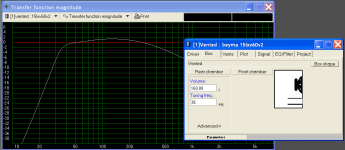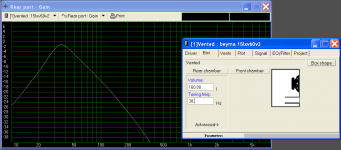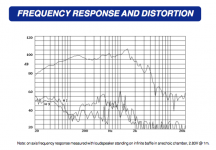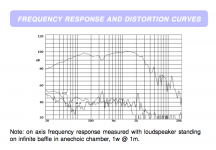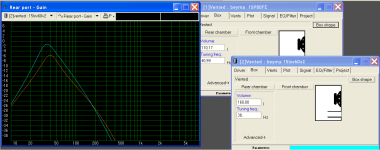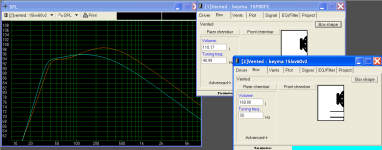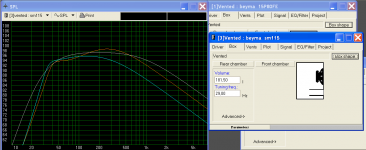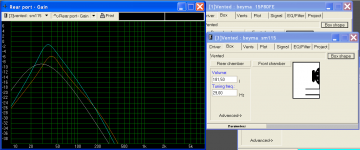I'm not thinking PA, more like large format studio monitors, think JBL 4430 or 4435. Those use 15" 2435's and 2234's and crossover at 1kHz. They are 2 way and 2.5 way. I'm listening to 4435's right now.
The 2220 has all the tricks for a low distortion midbass, thick top plate, underhung voice coil in a very thin precise gap and a light curvelinear cone, they just sound great. Next choice would be the 2234 then E130 (with a felt dust cap) then the 2225. I think all of them sound better than the 2226.
My last 2¢
The 2220 has all the tricks for a low distortion midbass, thick top plate, underhung voice coil in a very thin precise gap and a light curvelinear cone, they just sound great. Next choice would be the 2234 then E130 (with a felt dust cap) then the 2225. I think all of them sound better than the 2226.
My last 2¢
Thank you. This was the sort of information I was looking for.I'm not thinking PA, more like large format studio monitors, think JBL 4430 or 4435. Those use 15" 2435's and 2234's and crossover at 1kHz. They are 2 way and 2.5 way. I'm listening to 4435's right now.
The 2220 has all the tricks for a low distortion midbass, thick top plate, underhung voice coil in a very thin precise gap and a light curvelinear cone, they just sound great. Next choice would be the 2234 then E130 (with a felt dust cap) then the 2225. I think all of them sound better than the 2226.
My last 2¢
I looked and JBL 2220 are not very spendy. Anything to look out for?
Spend the time to find a nice clean pair. The cones are thin and will wrinkle if driven really hard and since the magnetic gap is narrow be sure the there is no voice coil rub or scratchiness. Is that a word?
There are 8 and 16 ohm units with AlNiCo and ferrite motors. Just be sure your pair matches. The 2220 motor is unique, you can put a 2225, 2235, E130 cone in it but it won't be right so be sure that what you buy is a proper 2220. The good news is they made a ton of them so with a little care and patience you should be able to find a real nice pair.
There are 8 and 16 ohm units with AlNiCo and ferrite motors. Just be sure your pair matches. The 2220 motor is unique, you can put a 2225, 2235, E130 cone in it but it won't be right so be sure that what you buy is a proper 2220. The good news is they made a ton of them so with a little care and patience you should be able to find a real nice pair.
Thanks for the Tips. I looked them up and see a Qts of .17 LOL, these beasts are not going to like an OB. But very interesting as a mid-base for what I was looking for in regards to the horn / waveguide projects.Spend the time to find a nice clean pair. The cones are thin and will wrinkle if driven really hard and since the magnetic gap is narrow be sure the there is no voice coil rub or scratchiness. Is that a word?
There are 8 and 16 ohm units with AlNiCo and ferrite motors. Just be sure your pair matches. The 2220 motor is unique, you can put a 2225, 2235, E130 cone in it but it won't be right so be sure that what you buy is a proper 2220. The good news is they made a ton of them so with a little care and patience you should be able to find a real nice pair.
Another detail often overlooked: A studio monitor's job is to help the engineer find anything wrong with the mix. It is a tool. Classic was the old L100, home version of their studio monitor. Man could it make problems in the midrange jump out into a horrible scream. Not what I want in my living room. The LS35a was another famous example. As speaker drivers have made great advances in the last decades, we can now build monitors that are highly accurate instead. It might make the engineers job a little harder, but can lead to even better results.
The JBL's are probably the head of their class. I would encourage some measurements on mid-range response, decay, and breakup issues. I have only heard them and not measured them, but I am confident what I hear is easily measurable.
Others may follow what Klipish published many years ago showing that all things being equal, distortion and efficiency are inversely proportional. This would give the inherent edge to high efficiency systems like the JBL's. (horn and waveguides included) I would love to hear the GedLee systems to see what Earl has done with modern drivers that Paul never had the advantage of.
OB at LF seems pointless to me as at low frequencies, the speaker is basically omnidirectional already. For those who don't understand how boxes work or have been led to believe there is something "boxey" about the sound, there is quite a following of IB for low frequencies. Look up The Cult of the Infinitelly Baffled. Again, go see what Linkwitz did with his 10's in an H frame OB. BTW, the Peerless carbon/paper 10's and 12's are very very clean drivers and can actually reach the low hundreds cleanly. They are not efficient or cheap.
Another source of large cone high efficiency midranges are the full range driver offerings. These, like the big JBL, use a light weight cone that breaks up giving the impression of extended highs, but if you are looking for a 100 to 1K driver, one may do very well here as that range avoids the large excursion low end they can'd to and the midrange breakup they do. Look at the 8 and 10 inch offerings. They may be well out of your price range though. I bet the "pro" 8 inch midranges are a better value.
The JBL's are probably the head of their class. I would encourage some measurements on mid-range response, decay, and breakup issues. I have only heard them and not measured them, but I am confident what I hear is easily measurable.
Others may follow what Klipish published many years ago showing that all things being equal, distortion and efficiency are inversely proportional. This would give the inherent edge to high efficiency systems like the JBL's. (horn and waveguides included) I would love to hear the GedLee systems to see what Earl has done with modern drivers that Paul never had the advantage of.
OB at LF seems pointless to me as at low frequencies, the speaker is basically omnidirectional already. For those who don't understand how boxes work or have been led to believe there is something "boxey" about the sound, there is quite a following of IB for low frequencies. Look up The Cult of the Infinitelly Baffled. Again, go see what Linkwitz did with his 10's in an H frame OB. BTW, the Peerless carbon/paper 10's and 12's are very very clean drivers and can actually reach the low hundreds cleanly. They are not efficient or cheap.
Another source of large cone high efficiency midranges are the full range driver offerings. These, like the big JBL, use a light weight cone that breaks up giving the impression of extended highs, but if you are looking for a 100 to 1K driver, one may do very well here as that range avoids the large excursion low end they can'd to and the midrange breakup they do. Look at the 8 and 10 inch offerings. They may be well out of your price range though. I bet the "pro" 8 inch midranges are a better value.
USHER 15HM Studiousher 15" I do not know the type number not cheep.
Beyma 15lx60v2 best one for good low end and good SPL.
See sim beyma. -6dB 26hz 96db 1Wmtr.
Attachments
Last edited:
My #2 project is a GETLEE Suma Homage using the 15" SEOS Waveguide and a 15" midbase. Earl uses the B&C 15TBX100, but I was thinking that I could use an equivalent JBL and get simular results, since I didn't need a new driver.Others may follow what Klipish published many years ago showing that all things being equal, distortion and efficiency are inversely proportional. This would give the inherent edge to high efficiency systems like the JBL's. (horn and waveguides included) I would love to hear the GedLee systems to see what Earl has done with modern drivers that Paul never had the advantage of.
Here is the waveguide Solid Surface SEOS-15? - SEOS? - Resin - The SEOS? Project DIY Sound Group.
I have made two Orion "clone" speakers to hear what the fuss was about. I read Linkwitz Lab - Loudspeaker Design My bottom line is that I like the sound, but its expensive, requiring about 4 times the woofer displacement for the same performance.OB at LF seems pointless to me as at low frequencies, the speaker is basically omnidirectional already. For those who don't understand how boxes work or have been led to believe there is something "boxey" about the sound, there is quite a following of IB for low frequencies. Look up The Cult of the Infinitelly Baffled. Again, go see what Linkwitz did with his 10's in an H frame OB. BTW, the Peerless carbon/paper 10's and 12's are very very clean drivers and can actually reach the low hundreds cleanly. They are not efficient or cheap.
Interesting Idea. I will look to see if I find something I can use.Another source of large cone high efficiency midranges are the full range driver offerings. These, like the big JBL, use a light weight cone that breaks up giving the impression of extended highs, but if you are looking for a 100 to 1K driver, one may do very well here as that range avoids the large excursion low end they can'd to and the midrange breakup they do. Look at the 8 and 10 inch offerings. They may be well out of your price range though. I bet the "pro" 8 inch midranges are a better value.
Last edited:
You may well be right. But I have enough reports of successes that I want to find out for myself.I don't think using a 15 incher as a mid-bass is a good idea. you can simply go for a 12 incher of B&C or other nice woofs. IMHO
The JBL's are probably the head of their class. I would encourage some measurements on mid-range response, decay, and breakup issues.
Another source of large cone high efficiency midranges are the full range driver offerings. These, like the big JBL, use a light weight cone that breaks up giving the impression of extended highs, but if you are looking for a 100 to 1K driver, one may do very well here as that range avoids the large excursion low end they can'd to and the midrange breakup they do.
It may simply be semantics but I think there is a difference between break-up and ringing "giving the impression of extended highs" and the progressive de-coupling of the outer portion of the cone allowing a light and low Le coil to continue to generate HF.
I am often looking for high spl and subbas. The beyma was the best one I could find and not extreme expensive.Helmuth,
Nice Woofer, but it doesn't look like it goes very high in your sym.
I would use it up to 500Hz but 1kHz is also possible.
Attachments
when you look at the THD of woofers they can have very low distortion at higher frequencies and very low extrusion that let them sound good.It may simply be semantics but I think there is a difference between break-up and ringing "giving the impression of extended highs" and the progressive de-coupling of the outer portion of the cone allowing a light and low Le coil to continue to generate HF.
Like this sm115/n not expensive at all and high end THD.
third and second harmonic around -55dB. The low and thd is sensational good.
Attachments
Last edited:
Like I already thought the 15lx60v2 is best in band with and efficiency.
the 15p80fe (orange) can work in a small box but not as good at 30Hz as the 15lx60v2(bleu).
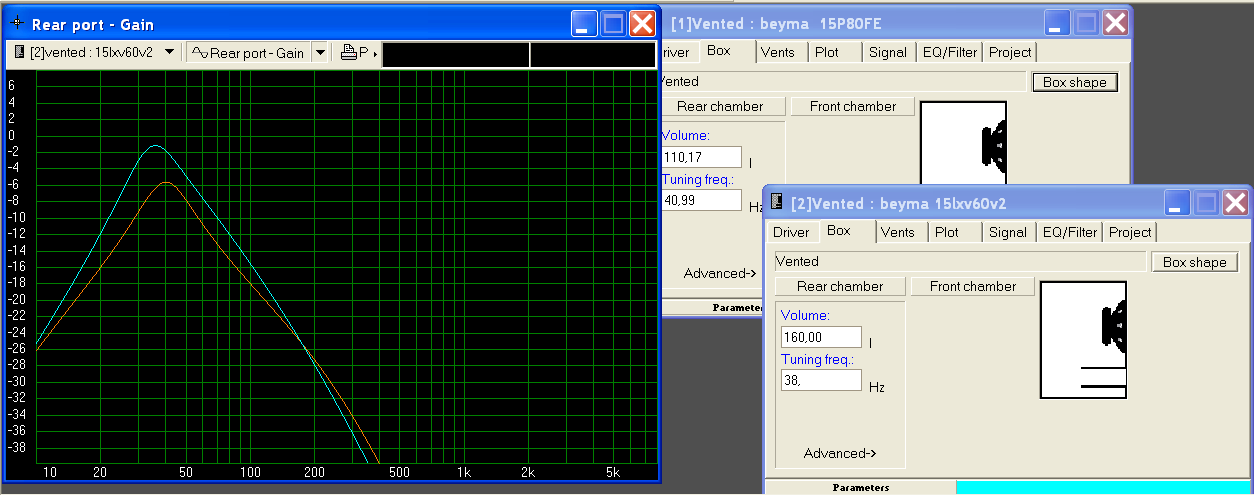
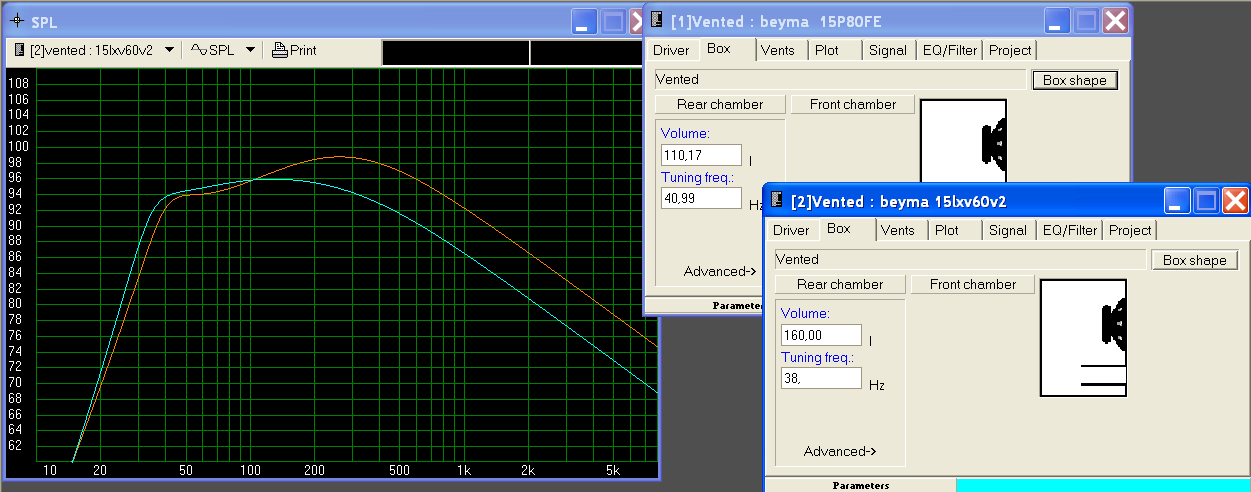
the 15p80fe (orange) can work in a small box but not as good at 30Hz as the 15lx60v2(bleu).
Attachments
It may simply be semantics but I think there is a difference between break-up and ringing "giving the impression of extended highs" and the progressive de-coupling of the outer portion of the cone allowing a light and low Le coil to continue to generate HF.
Talking both things. Decoupling is the more desirable way they work, but breakup is another. Yes, "ringing" of different zones at different frequencies. The problem with decoupling is it means the cone is not working as a piston and the distortion will be much higher. It just plain is not easy! Just thinking bask on all the papers JBL has published on breakup modes, bell-mode, teeter-totter modes and dampening materials. They know what they are doing, but that still does not make using the wrong driver for the application that much better.
- Status
- This old topic is closed. If you want to reopen this topic, contact a moderator using the "Report Post" button.
- Home
- Loudspeakers
- Multi-Way
- Looking for recomendations on 15" woofers
